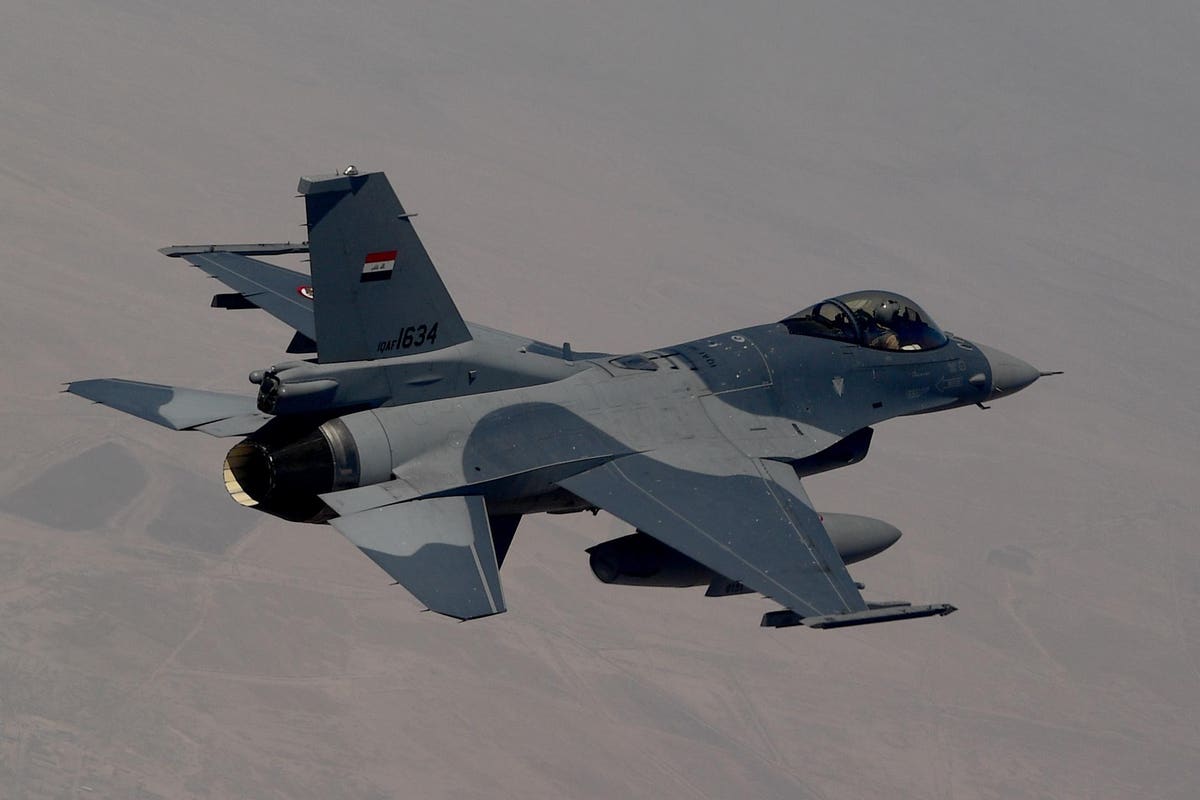Iraq’s F-16C/D Block 52 Viper fighter jets have become indispensable for Baghdad’s ongoing air campaign against Islamic State (ISIS) remnants. They could become even more invaluable for Iraq if the U.S. supplies more advanced air-to-air missiles than it has hitherto proved willing.
“The F-16 remains Iraq’s primary combat aircraft for targeting ISIS targets and defending Iraqi airspace,” according to the U.S. Defense Department’s Office of the Inspector General (OIG) latest quarterly report on Operation Inherent Resolve against ISIS.
However, the report also revealed that Iraq still relies entirely on the U.S.-led coalition’s intelligence, surveillance, and reconnaissance (ISR) capabilities “to spot, positively identify, and laser designate ISIS targets for ISF (Iraqi Security Forces) F-16s.”
The F-16s used 500-pound GBU-12 and 2,000-pound GBU-10 laser-guided bombs for all strikes executed during that quarter. The F-16 remains the Iraqi Air Force’s (IqAF) main strike platform given its capability to use various precision-guided munitions (PGMs). The only other aircraft Iraq currently has with this capability is its bulky AC-208 Combat Caravans, which can fire AGM-114 Hellfire air-to-ground PGMs. Notably, the AC-208 only carried out a single strike throughout the past quarter.
In the last quarter of 2021, AC-208s were the main strike platforms alongside F-16s. Iraq’s Czech L-159 light combat aircraft are not equipped with laser designation pods and have only dropped unguided general-purpose bombs like the Mark-82. Its Russian Su-25 Frogfoot attack planes are primarily used for training since they can only carry unguided rockets and bombs, which are unreliable for this campaign. It appears Iraq used neither of these two aircraft in the last quarter.
Iraq has relied more on its F-16s since its Russian military hardware has become increasingly unreliable. Since Russia invaded Ukraine in February 2022, it has had trouble supplying clients like Iraq with spare parts and technical support due to Western sanctions and increased requirements for its own beleaguered military. Consequently, Iraq can no longer depend on its Russian rotary-wing fleet, consisting of Mi-28 Havoc and Mi-35 Hind attack and Mi-17 utility helicopters.
In its report covering the first quarter of 2023, the OIG noted that Iraq did not use any of its Russian aircraft in anti-ISIS operations. In fact, it “continued to use only U.S.-supplied aircraft in its fleet for strikes.”
Iraq plans to replace its Mi-17s, essential for supporting ground operations and carrying out medevacs, with new American Bell 412EPXs and Bell 412Ms. The latest OIG report noted that “substantial progress” has been made in delivering additional Bell helicopters by the end of this year, adding that Iraq’s Russian aircraft “remain in disrepair.”
The OIG estimates that Iraq’s F-16 fleet remains 66 percent mission capable, the exact estimate it used in the previous quarter. That is impressive when one considers the dire forecasts from 2020-2021 indicating Iraq’s Vipers were falling into disrepair, putting the very future of the fleet into serious question. And while Iraq still relies heavily on American support and supplies to keep these fighters fully operational, their recent prominence in Iraq’s anti-ISIS air campaign demonstrates their continued usefulness as strike aircraft.
Now, if the United States went one step further and supplied Iraq with armaments that could make its F-16s more effective for air defense, the value of these aircraft for Baghdad would increase even more.
And there are emergent signs Washington might do just that.
Iraq’s Vipers only came equipped with obsolescent AIM-7 Sparrow medium-range semi-active radar-homing air-to-air missiles, significantly limiting their utility for air defense. The OIG report notes that these missiles “remain a point of concern due to broken guidance devices that lack spares and vendors able to perform repairs.”
And while not all F-16s are affected, the report goes on to note that “as the devices break on remaining aircraft,” the IrAF’s “air-to-air capability will diminish.”
It then revealed that one course of action presently under consideration “is for a request to replace the IqAF’s AIM-7 missiles with more capable AIM-120 AMRAAM missiles.”
The AIM-120 is a beyond-visual-range air-to-air missile that is far superior to the AIM-7. Arming Iraqi F-16s with this missile would greatly enhance those fighters’ underutilized air defense capability and markedly improve Iraq’s overall air defense.
Doing so could prove beneficial to the United States. Iraq has shown a growing interest in improving its limited air defenses in recent years. It recently acquired a ground-based radar from France and is believed to be interested in buying at least 14 French Dassault Rafale multirole fighters. As previously speculated here, Baghdad most likely seeks the Rafale for its Meteor air-to-air missile, the French equivalent of the AIM-120.
A timely provision of the AIM-120 would further add to Iraq’s growing use for – and appreciation of – its F-16s and potentially dissuade it from turning to France or elsewhere for substitutes.
Read the full article here





